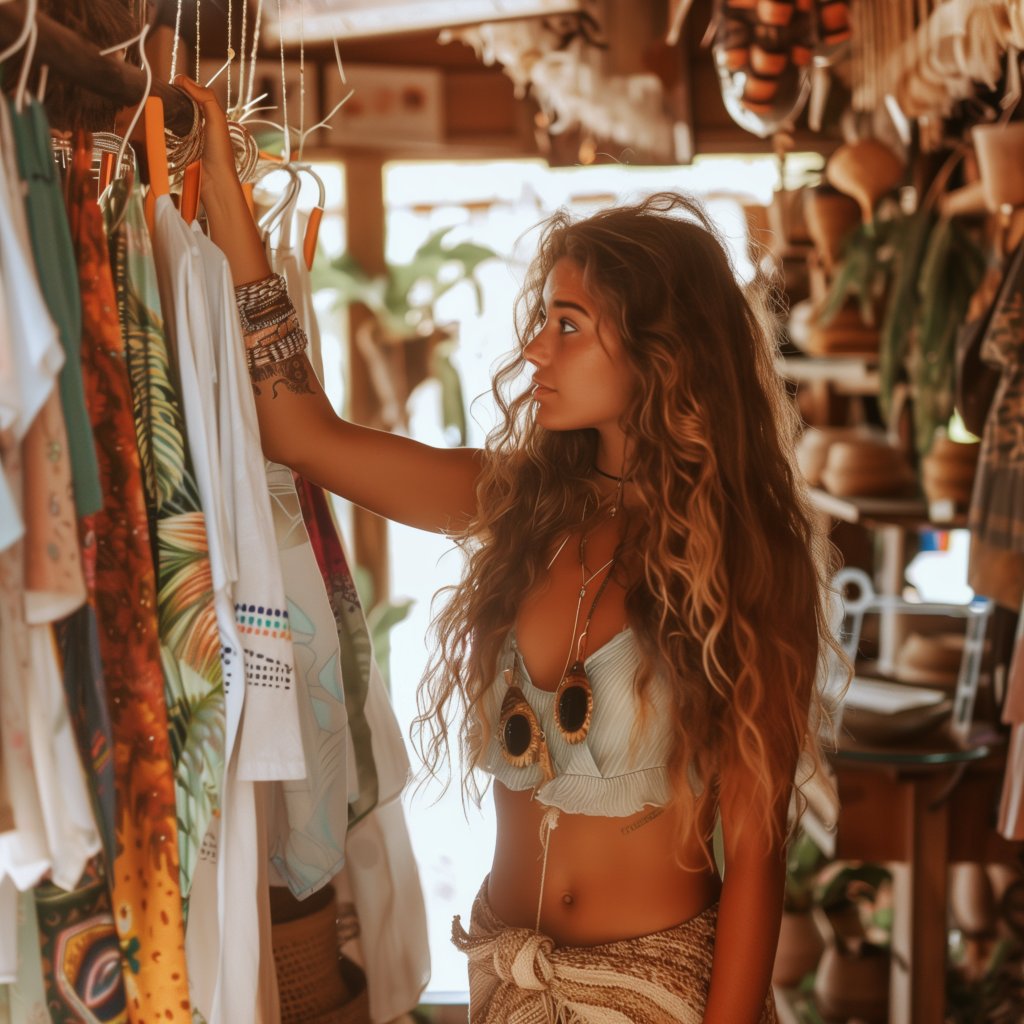
Hemp fabrics offer a range of interesting and beneficial properties that make them a unique choice for clothing and other textiles.
8 Fun Facts About Hemp Fabrics and Their Benefits:
- Exceptional Durability and Strength: Hemp fibers are incredibly strong, offering three to four times the strength of cotton. This makes hemp clothing highly durable, with the ability to last significantly longer than garments made from other fibers. For instance, a typical cotton T-shirt might last about 10 years, but a hemp T-shirt can last for 20 to 30 years.
- Softens Over Time: Unlike many materials that wear out with frequent washing and use, hemp fabric becomes softer, more absorbent, and more comfortable with each wash. This characteristic is unique among natural fibers and adds to the longevity and comfort of hemp textiles.
- Thermal Regulation: Hemp fabric is known for its ability to regulate temperature, making it comfortable to wear in both warm and cool climates. The structure of hemp fibers allows the fabric to be breathable, which helps in maintaining the body’s natural temperature.
- Eco-Friendly: Hemp is an environmentally sustainable choice. It grows densely, reducing the need for pesticides and herbicides, and it improves the soil’s quality by returning 60-70% of the nutrients it takes. Hemp also uses significantly less water compared to cotton, both in cultivation and processing.
- UV Protection: Hemp fabric provides natural protection against the sun’s radiation, which is an added benefit for outdoor wear.
- Antimicrobial Properties: Hemp is naturally antimicrobial and resistant to mold and mildew. This makes it an excellent choice for clothing, as well as for home textiles like bed sheets and towels, which benefit from resistance to bacteria and fungi.
- Versatility in Use: Hemp can be blended with other fibers to create a variety of textures and strengths. It can mimic the softness of cotton when blended with it, or offer the durability of linen when used in its pure form. This versatility extends to a wide range of products beyond clothing, including ropes, canvas, and even building materials.
- Historical Significance: Hemp has been used for thousands of years, with evidence of its use in textiles dating back to 8,000 BC in Mesopotamia. It was also historically used for maritime purposes, such as sails and rigging, due to its strength and durability.
Hemp fabric, derived from the hemp plant stem, is gaining popularity as a more eco-friendly and biodegradable alternative to other fibers. It has a long history, dating back thousands of years, and was widely used for various purposes.

Hemp fabric has many applications, including personal wear, home linen, gardening accessories, painting canvases, and cloth baby diapers. Its sustainability is one of its key advantages, as it requires less water and can be grown in less fertile soil than other crops like cotton.
Additionally, hemp fabric is known for its strength, UV resistance, thermoregulating properties, and water absorbency.
Key Takeaways:
- Hemp fabric is an eco-friendly and biodegradable alternative to other fibers.
- The production process of hemp fabric involves several steps, including growing, retting, extracting, combing, and spinning.
- Hemp fabric has a wide range of applications, including personal wear, home linen, gardening accessories, painting canvases, and cloth baby diapers.
- Hemp fabric is sustainable, requiring less water and less fertile soil compared to crops like cotton.
- Hemp fabric is known for its strength, UV resistance, thermoregulating properties, and water absorbency.
The Environmental Benefits of Hemp Fabric
Hemp fabric offers numerous environmental benefits, making it a sustainable and eco-friendly choice for those seeking natural textile options. Its production process is more sustainable compared to other fabrics, and hemp plants grow quickly, allowing for higher fiber production per hectare. Additionally, hemp does not deplete the soil and requires significantly less water compared to crops like cotton. These factors contribute to a reduced carbon footprint and make hemp fabric a great alternative to non-biodegradable synthetic fibers.

One of the key advantages of hemp fabric is its complete biodegradability. Unlike synthetic fabrics that contribute to pollution and microplastic waste, hemp fabric naturally decomposes over time without harming the environment. Furthermore, hemp fabric is recyclable and can be repurposed instead of ending up in landfills. By choosing hemp fabric, individuals can promote a circular economy and minimize their ecological impact.
Another notable environmental benefit of hemp fabric is its cultivation without the use of harmful chemicals. Hemp plants are naturally resistant to pests, reducing the need for pesticides and insecticides. This cultivation method helps protect the soil, water sources, and biodiversity. By opting for organic hemp fabrics, individuals can support sustainable farming practices and contribute to a healthier planet.
“Hemp fabric is highly regarded for its environmental benefits. It is considered one of the most sustainable fabric options available, as it is completely natural, biodegradable, and recyclable.”
| Environmental Benefits of Hemp Fabric | Other Fabrics |
|---|---|
| Hemp fabric is biodegradable and recyclable, reducing waste and promoting a circular economy. | Many fabrics, such as synthetic ones, contribute to pollution and microplastic waste, harming the environment. |
| Hemp cultivation requires significantly less water compared to crops like cotton, minimizing water usage. | Cotton production consumes vast amounts of water, leading to water scarcity in certain regions. |
| Hemp plants naturally resist pests, reducing the need for harmful pesticides and insecticides. | Conventional fabrics often rely on chemical pesticides and insecticides, which harm the environment and human health. |
Overall, the environmental benefits of hemp fabric are undeniable. By choosing sustainable and organic hemp fabrics, individuals can contribute to a greener future, reduce their carbon footprint, and promote a more eco-friendly fashion industry.
The Characteristics of Hemp Fabric
Hemp fabric possesses a range of unique and desirable characteristics that set it apart from other fabrics. Its exceptional strength, eight times that of other fabrics used for daily wear, ensures durability and longevity in hemp clothing. This makes it an excellent choice for garments that withstand frequent use and washing. Furthermore, hemp fabric is gentle on the soil, as it does not deplete soil nutrients like other crops.
In addition to its durability and soil-friendly properties, hemp fabric offers exceptional protection against the sun’s harmful rays. Its natural UV resistance makes it an ideal choice for clothing, particularly for outdoor activities. Additionally, hemp fabric has inherent antimicrobial properties, making it naturally resistant to bacterial growth and odors. This makes it an excellent choice for garments that require frequent movement and high activity levels.

Moreover, hemp fabric has outstanding thermoregulating properties, allowing it to adapt to various climates and keep the wearer comfortable. It provides warmth in cold weather and breathability in hot weather, ensuring optimal comfort throughout the year. Furthermore, hemp fabric is resistant to wrinkles, resulting in clothing that maintains a crisp and neat appearance even after extended use.
| Characteristics of Hemp Fabric | Advantages |
|---|---|
| Strength | Eight times stronger than other fabrics |
| Soil-Friendly | Does not deplete soil nutrients |
| UV Resistance | Provides excellent protection against harmful sun rays |
| Antimicrobial | Naturally resistant to bacterial growth and odors |
| Thermoregulating | Keeps the wearer warm in cold weather and cool in hot weather |
| Wrinkle-Resistant | Maintains a neat and crisp appearance |
The Versatility of Hemp Fabric
Aside from its remarkable properties, hemp fabric is also highly versatile in terms of its applications. It is widely used in the production of clothing, including shirts, pants, dresses, and outerwear. Hemp fabric can be styled to suit modern fashion trends, offering a chic and sustainable alternative to traditional materials.
In addition to clothing, hemp fabric is also utilized in the creation of accessories such as bags, hats, and shoes. Its durability and strength make it an excellent choice for items that require resilience and longevity. Furthermore, hemp fabric’s water absorbency makes it ideal for dyeing with natural colors, resulting in a wide range of vibrant and attractive hues.
The Growing Popularity of Hemp Fabric
Hemp fabric is quickly gaining popularity as more and more people recognize its numerous benefits and its potential to reduce our environmental impact. The demand for sustainable fabrics has been steadily increasing, prompting many companies to offer products made from hemp fabric. From clothing and accessories to home goods and outdoor gear, hemp fabric is being incorporated into a wide range of products.
In specialized stores and online platforms, you can find hemp clothing in various styles and designs. Hemp shirts, pants, and dresses are not only fashionable but also durable and breathable. Hemp fabric is known for its strength, so you can trust that your hemp clothing will last longer compared to garments made from other fabrics. Additionally, hemp fabric is hypoallergenic and naturally antimicrobial, making it a great choice for those with sensitive skin or allergies.

But it’s not just clothing that is benefiting from the growing popularity of hemp fabric. Sheets, towels, and other home linens made from hemp are becoming more readily available. The water absorbency of hemp fabric makes it perfect for bath towels, while its thermoregulating properties ensure a comfortable night’s sleep when used as bed sheets.
Hemp fabric is also being used in the production of bags, shoes, and other accessories, offering consumers a sustainable and stylish alternative.
| Hemp Fabric Uses | Hemp Clothing |
|---|---|
| – Clothing | – Shirts |
| – Home Linen | – Pants |
| – Accessories | – Dresses |
| – Bags | – Jackets |
| – Shoes | – Activewear |
As the demand for sustainable and eco-friendly options continues to grow, the versatility and sustainability of hemp fabric make it a top choice among consumers.
Whether it’s for personal wear, home goods, or outdoor gear, hemp fabric offers a stylish and environmentally conscious alternative that aligns with our values.
Hemp Fabric vs. Other Fabrics
When it comes to comparing hemp fabric to other fabrics, there are several key factors to consider. Let’s take a closer look at how hemp fabric stacks up against bamboo fabric, cotton fabric, and synthetic fabrics.
Hemp Fabric vs. Bamboo Fabric
While bamboo fabric is often touted as an eco-friendly option, the reality is that the production process of bamboo fabric involves the use of chemicals, making it less environmentally friendly than commonly believed. In contrast, hemp fabric is completely natural and grown without the use of harmful chemicals. Additionally, hemp fabric requires less water to grow, making it a more sustainable choice.
Hemp Fabric vs. Cotton Fabric
Cotton fabric is one of the most widely used fabrics in the world, but it comes with significant environmental drawbacks. Cotton cultivation requires large amounts of water and the use of pesticides and insecticides, which can harm the environment and workers. Hemp fabric, on the other hand, requires less water to grow and can be grown without the use of harmful chemicals. It is also stronger and more durable than cotton, making it a better long-term investment.
Hemp Fabric vs. Synthetic Fabric
Synthetic fabrics, like polyester and nylon, are derived from fossil fuel oils and contribute to pollution and microplastic waste. These fabrics are not biodegradable and can take hundreds of years to break down. In contrast, hemp fabric is completely biodegradable and has a minimal environmental impact. It is a sustainable alternative to synthetic fabrics and offers superior durability and strength.
| Hemp Fabric | Bamboo Fabric | Cotton Fabric | Synthetic Fabric | |
|---|---|---|---|---|
| Environmental Impact | Low | Medium | High | High |
| Water Usage | Low | Medium | High | High |
| Chemical Usage | None | Chemicals used in processing | Pesticides and insecticides used in cultivation | Derived from fossil fuel oils |
| Durability | High | Medium | Medium | Low |
| Biodegradability | High | Low | Low | Low |
As the table above illustrates, hemp fabric stands out as a more sustainable and eco-friendly choice compared to bamboo, cotton, and synthetic fabrics. Its low environmental impact, minimal water usage, and biodegradability make it a top choice for those seeking sustainable textile options.
Overcoming Misconceptions about Hemp Fabric
Despite its many benefits, hemp fabric has long been associated with misconceptions and biases due to its relation to marijuana. However, it’s important to understand that hemp fabric is highly versatile and can be just as soft and comfortable as linen or fleece.
Brands specializing in hemp fabric products have emerged, offering a wide range of modern styles and fashion-forward designs. Large companies have also recognized the growing demand for sustainable options and started incorporating hemp fabric into their offerings.
Hemp fabric is not only a sustainable choice but also a chic one. It’s gaining popularity among consumers who prioritize eco-friendly and ethical fashion.
By choosing hemp clothing, you can make a positive impact on the environment while still staying fashionable and comfortable. Furthermore, hemp fabric is known for its durability, making it a long-lasting investment in your wardrobe.
The Benefits of Hemp Fabric
There are several key benefits of hemp fabric that make it an excellent choice for clothing:
- Hemp fabric is highly breathable, allowing air to circulate and keeping you cool in hot weather.
- It has natural antimicrobial properties, making it resistant to odor-causing bacteria.
- Hemp fabric is UV resistant, providing protection against the harmful rays of the sun.
- It is hypoallergenic and gentle on sensitive skin, making it suitable for people with allergies or skin conditions.
- Hemp fabric is moisture-wicking and absorbs sweat, keeping you dry and comfortable.

“Hemp fabric is not only a sustainable choice but also a chic one.”
By understanding the benefits of hemp fabric and debunking misconceptions, we can embrace this eco-friendly alternative with confidence. Hemp clothing is not only good for the planet, but it also allows us to express our style while making a positive impact on the fashion industry. So next time you’re considering a new addition to your wardrobe, why not choose hemp fabric and be a part of the sustainable fashion movement?
| Hemp Fabric Benefits | Hemp Clothing Misconceptions |
|---|---|
| High breathability | Perceived as low-quality |
| Natural antimicrobial properties | Not stylish or fashionable |
| UV resistant | Difficult to find |
| Hypoallergenic | Less soft or comfortable |
| Moisture-wicking | Perceived as low quality |
The Origins of Hemp Fabric
Hemp fabric has a long and fascinating history that can be traced back thousands of years.
One of the earliest known origins of hemp fabric is in China, where it has been cultivated and used for various purposes for centuries. Chinese farms in northern regions, such as Shanxi, provide an ideal environment for hemp cultivation, and the expertise in hemp farming has been passed down through generations. This has made it economically viable for small farms to grow hemp and contribute to the production of high-quality Chinese hemp fabric.
Another renowned origin of hemp fabric is in Romania. Traditional methods of growing and processing hemp are still practiced in certain regions of the country, resulting in Romanian hemp fabric that is known for its exceptional quality.
These traditional methods prioritize sustainability and environmental friendliness, ensuring that the integrity of the hemp fibers is preserved throughout the production process.
Chinese Hemp Fabric
Chinese hemp fabric is highly regarded for its durability, strength, and versatility. It has been used in a wide range of applications, including clothing, textiles, and even ship sails. The rich history of hemp cultivation in China has led to the development of specialized techniques and expertise in producing high-quality hemp fabric.
Romanian Hemp Fabric
Romanian hemp fabric is celebrated for its traditional craftsmanship and sustainable production methods. The cultivation of hemp in Romania dates back centuries, and farmers have honed their techniques to ensure the highest quality fibers. The resulting Romanian hemp fabric is not only environmentally friendly but also possesses excellent strength and durability.
| Origin | Main Characteristics |
|---|---|
| Chinese Hemp Fabric | Durable, versatile, rich history of cultivation, specialized techniques |
| Romanian Hemp Fabric | Traditional craftsmanship, sustainable production methods, strong and durable fibers |
The Drawbacks of Other Fabrics
While hemp fabric offers numerous benefits and advantages, it’s important to acknowledge the drawbacks of other commonly used fabrics. Let’s look at the limitations of bamboo, cotton, and synthetic fabrics.
Bamboo Fabric:
While bamboo fabric is often touted as an eco-friendly alternative, it does have its drawbacks. The majority of bamboo fabric on the market is actually viscose bamboo, which requires a chemical-intensive process for extraction. This process involves the use of harmful chemicals, such as sodium hydroxide and carbon disulfide, which can have negative environmental impacts. Additionally, the production of bamboo fabric requires a significant amount of water, making it less sustainable than commonly perceived.
Cotton Fabric:
Although cotton is a widely used fabric, both conventional and non-organic cotton have their downsides. Non-organic cotton is known for its heavy reliance on pesticides and insecticides. The extensive use of these chemicals not only harms the environment but also poses health risks to farmers and workers. Furthermore, cotton cultivation requires large amounts of water, making it a water-intensive crop. This water usage contributes to water scarcity in regions where cotton is grown, particularly in arid areas.
Synthetic Fabrics:
Synthetic fabrics, such as polyester and nylon, are derived from fossil fuel oils and have significant environmental drawbacks. The production of synthetic fabrics contributes to pollution and carbon emissions, as it is an energy-intensive process. In addition, synthetic fabrics are non-biodegradable and contribute to microplastic pollution. As these fabrics break down over time, they release microplastic particles into the environment, which can harm marine life and ecosystems.
Considering these drawbacks, hemp fabric emerges as a more sustainable and ethical choice. Its production process requires less water and avoids the use of harmful chemicals. Additionally, hemp fabric is biodegradable and offers durability and strength comparable to other fabrics. By choosing hemp fabric, consumers can contribute to a more sustainable future for the textile industry.
| Fabric | Drawbacks |
|---|---|
| Bamboo Fabric | Chemical-intensive extraction process High water usage |
| Cotton Fabric | Pesticide and insecticide reliance Large water consumption |
| Synthetic Fabrics | Emission of pollutants and carbon Non-biodegradable, contributing to microplastic pollution |
| Hemp Fabric | Less water usage Avoidance of harmful chemicals Biodegradable |
Wrapping Up:
Hemp fabric is undoubtedly a sustainable and eco-friendly choice for consumers who are seeking natural, biodegradable, and stylish textile options. With its numerous benefits, such as strength, UV resistance, thermoregulation, and water absorbency, hemp fabric has proven to be a versatile material suitable for various applications.
While there have been historical misconceptions and biases surrounding hemp fabric, the increased demand for sustainable fashion has propelled its popularity. Not only are eco-conscious brands embracing hemp fabric, but even large companies are incorporating it into their product lines, promoting its use as a more ethical and environmentally friendly alternative.
Compared to other fabrics, hemp fabric stands out for its sustainability and durability. It surpasses fabrics like bamboo, cotton, and synthetic materials in terms of water usage, chemical reliance, and overall environmental impact. With its ability to be grown without harmful chemicals and its biodegradable nature, hemp fabric offers a truly sustainable choice for conscious consumers.
In conclusion, the rise of hemp fabric is revolutionizing the textile industry, providing a viable solution for those seeking a sustainable fabric choice. Its unique properties, combined with its eco-friendly production process, make hemp fabric a perfect fit for the growing demand in the fashion world. As we continue to prioritize eco-consciousness, hemp fabric will undoubtedly play a significant role in shaping the future of sustainable fashion.
FAQ
What is hemp fabric?
Hemp fabric is a textile material made from the fibers of the hemp plant’s stem.
What are the benefits of hemp fabric?
Hemp fabric is eco-friendly, biodegradable, and recyclable. It requires less water and can be grown in less fertile soil. It is also strong, UV-resistant, thermoregulating, and water-absorbent.
What are the environmental benefits of hemp fabric?
Hemp fabric is considered one of the most sustainable fabric options. It is completely natural, biodegradable, and recyclable. Hemp plants grow quickly and can produce more fibers per hectare than other sources. They do not deplete the soil and require less water to grow.
What are the characteristics of hemp fabric?
Hemp fabric is eight times stronger than other fabrics, easy on the soil, offers UV protection, has natural antimicrobial properties, becomes softer with age, and has excellent thermoregulating properties. It is also resistant to wrinkles and highly water-absorbent.
How is hemp fabric being used?
Hemp fabric has a wide range of applications, including personal wear, home linen, gardening accessories, painting canvases, and cloth baby diapers.
How does hemp fabric compare to other fabrics?
Hemp fabric is more sustainable and durable compared to fabrics like bamboo, cotton, and synthetic options. It requires less water, is grown without harmful chemicals, and is biodegradable.
What are the misconceptions about hemp fabric?
Hemp fabric has long been associated with marijuana, but it is highly versatile and can be made into various styles and designs. It is shedding its outdated stereotypes and becoming a chic and sustainable choice.
Where does hemp fabric originate from?
Hemp fabric has a rich history, with origins traced back to China thousands of years ago. It is also renowned in Romanian hemp fabric, where traditional methods of growing and processing hemp are still practiced.
What are the drawbacks of other fabrics?
Bamboo fabric requires large amounts of water and chemicals during processing. Cotton fabric requires significant water usage, pesticides, and insecticides. Synthetic fabrics contribute to pollution and microplastic waste.
Why should I choose hemp fabric?
Hemp fabric offers a sustainable and eco-friendly choice for consumers seeking natural and biodegradable textile options. It is versatile, durable, and stylish, while also reducing the carbon footprint of the fashion industry.

0 Comments